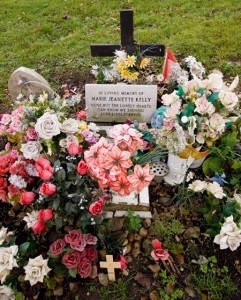Today Leyton Station is very busy indeed. It’s one of the Central Line Stops that people alight from to get in to the Olympic Park. As the thousands of visitors leave the tube trains they might catch a glimpse of a sprawling cemetery. This is St Patrick’s Roman Catholic Cemetery. But what few of them will realise is that they are looking at the place where Jack the Ripper’s final victim, Mary Kelly, lies buried.

I first paid a visit to her grave in 2004 when I was working on the drama/documentary Unmasking Jack the Ripper.
Despite the fact that the man in the cemetery office had pointed me in the general direction of the grave I actually passed it three times without realising it was in fact Mary Kelly’s Grave.
The Reason I did so?
It looked like a fresh grave. It was covered in flowers left by people from all over the world who had made special pilgrimages to view the final resting place of Jack the Ripper’s last victim. And there weren’t just floral tributes on the grave. Little wooden crosses, woollen teddy bears, dolls and even bottles of gin to which were attached cards on which were scrawled things like “have a drink on me Mary” had also been left on the grave.
It really does present the student of ripper history with something of a paradox, Because, if you think about it, people would not still be visiting the grave had it not been for the fact she was murdered by Jack the Ripper.
In truth, we can’t be sure that the memorial stone that greets visitors today does actually mark the final resting place of Mary Kelly, because this area of St Patrick’s Cemetery is in fact a common burial ground where many paupers have, over the years, been buried.
However in the Cemetery office you can still view the 19th Century Register of Burials and still read that long ago entry that records the internment of Jack the Ripper’s final victim, Marie Jeanette Kelly.

